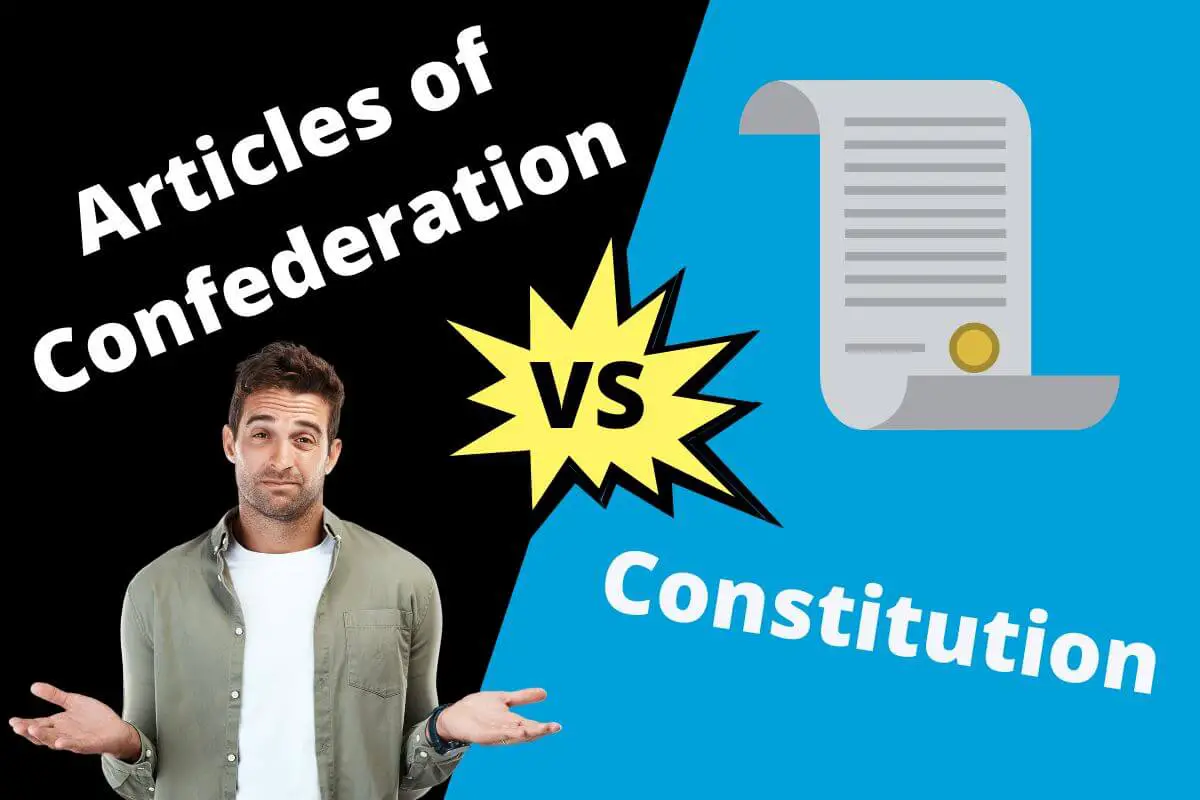The Articles of Confederation established a unicameral legislature. In contrast, the Constitution established a bicameral legislature.
The Articles of Confederation and the Constitution are the two governing documents of the United States of America. Both the Articles of Confederation and the Constitution are broad subjects, so there is a lot more to learn about how they differ than just this one difference.
Table of Contents
Comparing Articles of Confederation and Constitution
| Articles of Confederation | vs | Constitution |
| The first US constitution was established in 1789 after an agreement among the thirteen states of the US | Definition | The ultimate law of the country that even superseded the Articles of Confederation |
| 1781 to 1789 | Year of Implementation | 1789 |
| No system of federal courts | Federal Courts | Introduced the system of federal courts |
| It didn’t form any executive branch | Executive Branch | Formed an executive branch with the US president as the head, and he had power over the judiciary and the legislature and to choose cabinets. |
| Each state got one vote irrespective of the number of senates or the size of the states | Votes | Each representative or Senate got one vote each |
| It required the approval of all the thirteen states to pass an amendment | Approval for Amendments | Requires the approval of ¾ members of the legislative assembly and ⅔ members of both the houses |
| Requires the approval of nine out of thirteen states to pass a new law | Approval for Passing Laws | Requires the approval of 50% + 1 member of both the houses and the President’s signature |
| The state had complete sovereignty | Sovereignty The state had complete sovereignty The Constitution was established as the supreme law of the state |
The Constitution was established as the supreme law of the state |
| Congress was dependent on the states to raise an army | Raising an Army | Congress can raise an army independently during times of conflict |
What are the Articles of Confederation?
The Articles of Confederation were the first Constitution of the US that was drafted between 1781 to 1789.
This document was an agreement among the thirteen original states of America that connected the federal government and the initial government formed by the Continental Congress in the Revolutionary period.
Sovereignty of the States
One of the main principles of the Articles of Confederation is to establish and preserve the sovereignty of the states. It gave more power to the states and kept the central government from receiving limited powers.

What is the Constitution of the United States?
The Constitution of the United States is the ultimate law of the country. The Constitution was adopted in 1789 after 27 amendments and superseded the Articles of Confederation.
The Constitution separated the federal government into three parts- the legislative, comprising the bicameral Congress (Article I); the executive comprising the President and the subordinate officers (Article II); and the judicial branch comprising the Supreme courts and federal courts (Article III).

Articles of Confederation vs Constitution
The following are the primary differences between the Constitution and the Articles of confederation-
Legislature
The U.S. Constitution established a bicameral legislature that divided Congress into the Upper House (the Senate) and the Lower House (the house of representatives). But the Articles of Confederation established a unicameral government.
Judiciary
The Articles of Confederation didn’t introduce any federal court system. They levied all powers of the law on the state courts, but the Constitution changed this system. As soon as the Constitution overpowered the Articles of Confederation, it introduced the federal court system and gave it the responsibility to resolve disputes between the states and citizens.
Voting
The Articles of Confederation introduced the one-vote system for every state irrespective of the population and size. But the Constitution has changed the system to where every senator or representative of each state got one vote.
Executive Branch
The Articles of Confederation didn’t introduce any system of the executive branch. But the American Constitution has established an executive branch of the government where the Electoral College selects the President.
Formation of Laws
When the Articles of Confederation were the supreme governing power in the United States of America, the national government needed the approval of 9 out of 13 states to pass any new laws. But the ratification of the Constitution has changed the system wherein state governments only require the approval of more than half of the total nominees to pass a law.
Armed Forces
While the Articles of Confederation were in force, it allowed the states to raise their army. Still, the national government needed permission from the state if it had to raise its army when situations of conflict occurred. On the other hand, the Constitution gave complete liberty to the federal government to raise an army during conflicting situations.
Amendments
The national government needed the approval of the 13 states to pass any amendment during the supremacy of the Articles of Confederation. However, the Constitution introduced a new system where an amendment requires only the approval of 2/3rd members of the Upper and Lower House and the approval of 3/4th of state legislature members.
Taxes
The Articles of Confederation did not allow the state government to levy taxes. Still, the Constitution again rectified this system and let the state and federal governments impose taxes on the citizens.
Even though both the Articles of Confederation and the Constitution are governing documents, they have different ways of ruling the state.
If you’ve enjoyed this article, check out our post comparing police versus sheriff.

